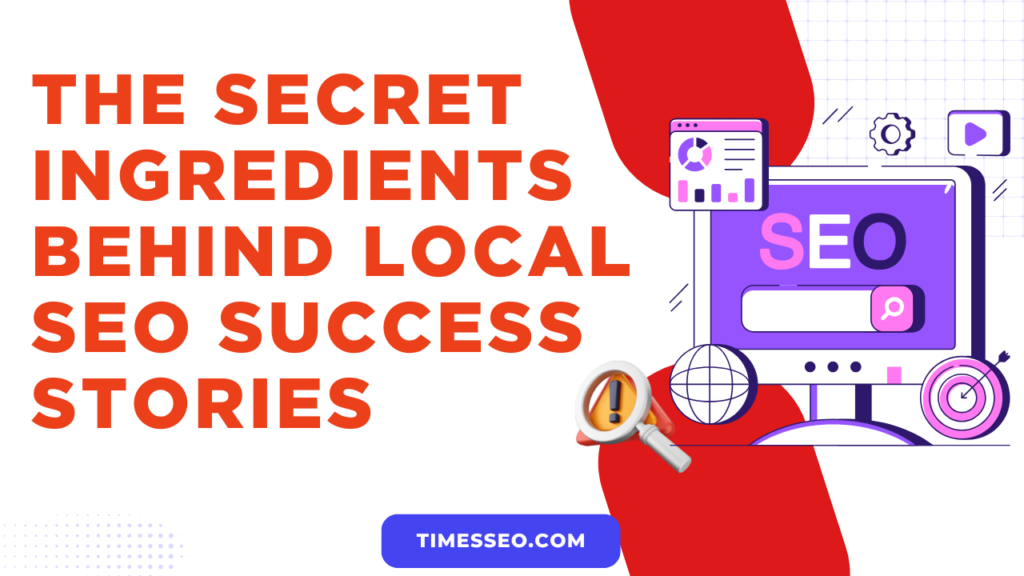
The Secret Ingredients Behind Local SEO Success Stories
Discover the secret ingredients behind local SEO success stories and learn how small businesses achieve top rankings. From Google Business Profile optimization to local content strategies, unlock the proven tactics that drive local search visibility.
Table of Contents
Introduction
Why Local SEO Success Stories Matter
Ever noticed how certain local businesses dominate Google Maps and “near me” searches, while others barely appear in the top results? When done correctly, local SEO works like magic.
Local SEO success stories are more than just marketing bragging rights—they’re proof that a well-executed strategy can transform a small shop into a neighborhood legend or a service provider into the go-to expert.
The Power of Local Visibility
When you rank well locally, you don’t just get clicks—you get customers walking through your door or calling your number. For small and medium-sized businesses, this is often the difference between just surviving and thriving.
Real-World Impact on Small and Medium Businesses
From doubling revenue in a matter of months to outshining national competitors, local SEO’s impact is tangible. And the best part? It’s achievable with the right “secret ingredients” that we’re about to unpack.
Understanding the Core of Local SEO
What Makes Local SEO Different from Traditional SEO
Local SEO targets clients in a particular region, as opposed to broad SEO, which strives for a national or worldwide audience.
Why Search Intent is King in Local Searches
When someone searches “best pizza near me” or “emergency plumber in [city],” they’re ready to act now. Understanding this intent—and tailoring your presence to match it—is at the heart of local SEO success.
Optimized Google Business Profile
In local search, your Google Business Profile (GBP) frequently serves as your initial impression.
Claiming and Verifying Your Profile
First things first—claim your listing and verify it. Without verification, you’re invisible on Google Maps.
Adding Complete and Accurate Information
Fill out everything: business hours, categories, services, website, and description. Include keywords naturally, but keep it human-friendly.
Leveraging Posts, Photos, and Q&A for Engagement
Google loves active profiles. Post weekly updates, add photos of your business, and answer customer questions to boost engagement.
Hyper-Local Keyword Strategy
Using Geo-Modifiers Effectively
Instead of targeting “plumber,” go for “plumber in Austin” or “emergency plumber Austin TX.” These geo-modifiers help you show up in relevant local searches.
Long-Tail Keywords for Local Dominance
Targeting “best vegan bakery in Brooklyn open late” might have fewer searches, but those searches are gold—high intent and low competition.
Positive Review Generation
Encouraging Authentic Reviews
Immediately following a purchase or service, ask satisfied customers for reviews. Timing is everything.
Responding to Both Positive and Negative Feedback
Thank customers for good reviews, and address bad reviews with professionalism. This shows you care and builds trust.
Local Link-Building
Partnering with Community Websites
Sponsor local blogs, collaborate with schools, or get featured on neighborhood directories.
Sponsoring Events for Backlinks
Event sponsorships often include backlinks from official websites, which Google values highly.
Mobile-Friendly Website Experience
Fast Loading Times and Easy Navigation
Over 60% of local searches happen on mobile. You’re losing leads if your website loads slowly.
Local Landing Pages for Each Service Area
Make a different landing page for every area you service if you have more than one. This improves relevance and ranking.
Consistent NAP Citations
What NAP is and Why Consistency Matters
NAP stands for Name, Address, Phone number. Maintain consistency across all platforms, including your social media accounts, directories, and website.
Tools to Manage Citations Effectively
Platforms like BrightLocal or Moz Local can help you maintain consistency across dozens of listings.
Location-Based Content Marketing
Localized Blog Posts and Guides
Write content like “Top 5 Things to Do in [City] This Summer” or “How to Choose a [Service] in [Neighborhood].”
Highlighting Community Involvement
Share stories about your participation in local charity events or partnerships—it builds trust and loyalty.
Participation in Social Media for Local Reach
Geo-Tagging and Location Hashtags
On Instagram or Facebook, tag your location and use local hashtags to reach nearby users.
Cross-Promoting with Local Influencers
If they have close connections to the community, even micro-influencers can increase foot traffic.
Monitoring and evaluating results for local SEO
Google Analytics and Google Search Console Insights
Track where your traffic is coming from and which keywords are performing best.
Using Heatmaps and Call Tracking
Tools like Hotjar or CallRail help you see exactly how users interact with your site and where calls are coming from.
Real Local SEO Success Stories
Case Study 1 – How a neighborhood café climbed to the top
A small café in Portland optimized their GBP, collected 200+ positive reviews in 6 months, and used Instagram geo-tags. The result? A 70% increase in walk-ins.
Case Study 2 – How a Plumber Increased Leads by Twofold in Six Months
By targeting “emergency plumber [city],” creating location-specific landing pages, and sponsoring a local sports team, a one-man plumbing business doubled his monthly leads.
Common Mistakes to Avoid in Local SEO
Keyword Stuffing with Location Names
Overusing location keywords looks spammy and can hurt rankings.
Ignoring Mobile Optimization
If your website isn’t mobile-friendly, you’re missing out on over half of your potential customers.
Future Trends in Local SEO
Voice Search Optimization for Local Intent
With more people using voice assistants, targeting natural phrases like “Where’s the nearest pizza place?” will be crucial.
AI-Driven Personalization
AI tools will tailor search results based on past behavior and preferences—meaning businesses will need to get even more targeted.
Conclusion
Local SEO isn’t a mystery—it’s a recipe. Just like a great recipe, the key lies in combining the right ingredients in the right manner. From optimizing your Google Business Profile to building genuine community connections, these tactics aren’t just theory—they’re proven strategies behind real success stories.
Frequently Asked Questions
Optimizing your Google Business Profile and collecting reviews usually gives the quickest boost.
There’s no magic number, but aim for at least 20–50 high-quality, recent reviews.
Not necessarily. Service-area businesses can still rank by setting service locations in GBP.
Yes! Social engagement drives brand awareness, which indirectly improves local search visibility.
At least once a week—fresh activity signals relevance to Google.
Table of Contents
Popular Posts
-
 Affordable Technical SEO Audit for Small Business: A Complete Guide26 Jun 2025 Blog
Affordable Technical SEO Audit for Small Business: A Complete Guide26 Jun 2025 Blog -
 How to Get an Affordable Technical SEO Audit for Small Business27 Jun 2025 Blog
How to Get an Affordable Technical SEO Audit for Small Business27 Jun 2025 Blog -
 The Ultimate Local SEO Audit Checklist for Startups28 Jun 2025 Blog
The Ultimate Local SEO Audit Checklist for Startups28 Jun 2025 Blog -
 Local SEO Audit Checklist for Startups: A Beginner’s Guide28 Jun 2025 Blog
Local SEO Audit Checklist for Startups: A Beginner’s Guide28 Jun 2025 Blog -
 Top On-Page SEO Audit Steps for Service Websites Every Business Should Know29 Jun 2025 Blog
Top On-Page SEO Audit Steps for Service Websites Every Business Should Know29 Jun 2025 Blog -
 Technical SEO for WordPress: The Ultimate Beginner’s Guide01 Jul 2025 Blog
Technical SEO for WordPress: The Ultimate Beginner’s Guide01 Jul 2025 Blog -
 The Impact of On-Page SEO Audit Steps for Service Websites on UX01 Jul 2025 Blog
The Impact of On-Page SEO Audit Steps for Service Websites on UX01 Jul 2025 Blog -
 Technical Mobile SEO Audit Tips for Developers02 Jul 2025 Blog
Technical Mobile SEO Audit Tips for Developers02 Jul 2025 Blog -
 Complete SEO Backlink Audit Guide for Better Google Rankings03 Jul 2025 Blog
Complete SEO Backlink Audit Guide for Better Google Rankings03 Jul 2025 Blog -
 Boost Your Rankings with Technical SEO for WordPress01 Jul 2025 Blog
Boost Your Rankings with Technical SEO for WordPress01 Jul 2025 Blog







